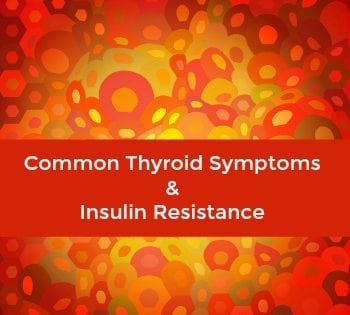Common Symptoms of Insulin Resistance
Insulin resistance has become so prevalent due to our modern lifestyle, lack of daily exercise, and a high intake of carbohydrates. When patients are advised to go gluten-free one of the mistakes I see them make is opting for a wide variety of packaged products labeled gluten-free whether it be crackers, chips, sweet treats, etc. It is important to understand that gluten-free packaged/processed foods are still mostly junk food and high in carbs which impact blood sugar and insulin levels dramatically. This usually leads to symptoms that mimic thyroid disease causing you to believe your symptoms are related to Hashimoto’s hypothyroidism when in fact may actually be caused by insulin resistance.
When you consider today’s typical modern lifestyle – it truly is potentially dangerous in that poor diet of packaged and processed foods (gluten-free or not) and lack of exercise over time causes the body to release greater than normal amounts of insulin to counteract increases in blood sugar triggered by carbs.
Eventually, the body’s cells become overwhelmed to the point they no longer respond to insulin and become “resistant” to the signal. You see, insulin is the “key” that unlocks the door on the cell to release sugar from the bloodstream into the cell where it may be utilized.
What results is that sugar cannot enter the cell, leaving you to crave even more carbs for energy, weight gain, or fatigue. You stop absorbing and using insulin. Insulin Resistance is a precursor to Type 2 diabetes, heart disease, Polycystic Ovarian Syndrome and other chronic health conditions but as you will learn shortly, the symptoms are often confused as symptoms of thyroid disease.
Unfortunately, insulin resistance is very common, and it also has multiple names, such as “metabolic syndrome,” “Syndrome X,” “pre-diabetes,” or “dysmetabolic syndrome.”
According to Medicine.net, recent studies found 32% of the US population having insulin resistance. Sadly, this number includes many children as well.
Top 11 Signs of Insulin Resistance
The following signs are potential indicators of insulin resistance especially in women. Please note that you don’t need to have ALL of them to be positive for insulin resistance. Also note that it is easy to understand why a few of these symptoms are sometimes assumed to be related to low thyroid function. And, although this could be the case, it’s very important to get tested. Please don’t self diagnose 🙂
• Weight gain, especially around the stomach & waist – insulin triggers the body to store fat, so increased levels of insulin caused by insulin resistance often create an increase in body fat. The waist is the most common location for body fat to accumulate caused by insulin resistance. People with insulin resistance often gain weight and find it impossible to lose weight despite eating less and exercising more.
• Fatigue – increased insulin levels and insulin resistance strain the body and this results in decreased energy levels. People who reverse insulin resistance often comment the increase in energy is their most favorite aspect of restoring their health.
• Polycystic Ovarian Syndrome – It is important to understand that PCOS has its origin in insulin resistance. Improving insulin sensitivity and controlling insulin levels should be a primary goal. Please check out this guest post by Amy Medling from PCOS Diva.
• Elevated DHEA and/or Testosterone – Unexplained or sudden weight gain can be an alarming occurrence for women, and it does not always signify you have been eating too many high-fat foods, and it does not necessarily mean that the weight gain is related to your thyroid. A hormonal imbalance can result in excess testosterone production and subsequent weight gain in women. Recognizing the symptoms of this imbalance can help you learn how to minimize weight gain.
• Feeling sleepy, especially after eating a large meal – insulin resistance often results in slightly elevated glucose levels after a big meal loaded with carbohydrates. The body puts such a high priority on digestion it will divert energy from other body systems to help digest the meal. This, combined with the energy-draining effects of elevated blood sugar often results in sleepiness.
• Elevated cholesterol and triglycerides – the body creates triglycerides from the carbohydrates we eat, not from the fats we eat. When the body’s metabolism is negatively affected by insulin resistance, cholesterol and triglyceride levels will rise.
• High blood pressure – one lesser known functions of insulin is to control the pressure inside blood vessels. If the body stops absorbing insulin, an increase in blood pressure is a very common sign. Improving insulin resistance should be the primary course of action for most people with high blood pressure.
• Brain fog or difficulty concentrating – high insulin levels affect brain chemicals and neurotransmitter balance, which may negatively affect concentration.
• Depression – due partly to the physical changes caused by insulin resistance and partly by the effects insulin resistance has on brain chemistry and neurotransmitter balance.
• Increased hunger or cravings – when insulin levels and/or blood sugars are elevated even slightly, the body stops turning food into energy. This results in a constant feeling of hunger or cravings for certain foods, especially carbs or sugar (bread, pasta, chocolate, cookies, cakes, etc.), or hunger as the body signals its need for fuel.
• High blood insulin levels – this is not high blood SUGAR – this is an elevation in fasting insulin because people with insulin resistance often have normal fasting glucose levels, especially during the early stages of the condition. A fasting glucose level is not a realistic reflection of the body’s normal state as most of us eat at least three times daily and very rarely fast more than 6-8 hours. The best way to detect insulin resistance is to measure the amount of insulin circulating in the bloodstream. Although many labs claim insulin levels as high as 18 are “normal,” subtle lifestyle changes should be implemented as soon as possible to prevent insulin levels from creeping above 8.
• Fatty liver disease – if left unchecked, insulin resistance and elevated triglyceride levels cause fat deposits to develop in the liver. These fat deposits can result in fatty liver disease – liver damage that is unrelated to alcohol consumption.
Please note that each of these symptoms may also be indicators of other health conditions. Do your homework and be sure to work with a healthcare practitioner who is knowledgeable about insulin resistance. Insulin resistance can often be reversed using simple modifications to lifestyle and eating habits.
A daily capsule of Berberine Synergy (as Berberine HCl 400mg combined with alpha lipoic acid 100mg) helps to support optimal blood sugar and has been found beneficial for the support of insulin resistance and elevated insulin levels, PCOS, non-alcoholic fatty liver disease and diabetes.

If you would like to go deeper and try our meal plans which can be personalized to your unique preferences and health needs take a look at our meal plan options.
References
http://mkt.s.designsforhealth.com/techsheets/Berberine-Synergy-References.pdf
http://www.livestrong.com/article/315045-high-testosterone-in-women-weight-gain/




